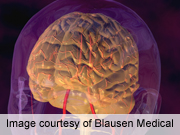- Double Mastectomy May Offer No Survival Benefit to Women With Breast Cancer
- Toxic Lead Found in Cinnamon Product, FDA Says
- Certain Abbott Blood Sugar Monitors May Give Incorrect Readings
- Athletes Can Expect High Ozone, Pollen Counts for Paris Olympics
- Fake Oxycontin Pills Widespread and Potentially Deadly: Report
- Shingles Vaccine Could Lower Dementia Risk
- Your Odds for Accidental Gun Death Rise Greatly in Certain States
- Kids From Poorer Families Less Likely to Survive Cancer
- Tough Workouts Won’t Trigger Cardiac Arrest in Folks With Long QT Syndrome
- At-Home Colon Cancer Test Can Save Lives
Imaging Provides New Insights Into Schizophrenia


THURSDAY, Sept. 19A new imaging study reveals abnormalities in the white matter of brains of people with schizophrenia.
Researchers used two types of brain imaging: magnetic resonance spectroscopy, which measures the levels of particular chemicals in the brain; and magnetization transfer imaging, which detects changes in the level of myelin in the brain’s white matter.
Nerve cells must be insulated by myelin to effectively transmit signals from one part of the brain to the other, explained the authors of the study published Sept. 15 in the journal Biological Psychiatry.
“The notion that the brain in schizophrenia is characterized by abnormalities in connections between distant brain regions is not new, and imaging studies using diffusion tensor imaging have long suggested that the white matter where these connections travel is abnormal in this condition,” study senior author Dr. Dost Ongur, of Harvard Medical School, said in a journal news release.
“However, we have not had the tools to determine whether the abnormalities are in axons, or the myelin sheath around the axons, or both,” Ongur added.
The researchers found evidence of abnormalities in both myelin and axons (nerve cell projections) in patients with schizophrenia, a serious psychiatric disorder. More specifically, they found reduced myelination of white matter pathways in people with schizophrenia, and also abnormal spread of a type of small molecule (called N-acetylaspartate) thought to be mainly contained within nerve cells.
The findings are important because they suggest that “the white matter abnormalities in schizophrenia are complex and interconnected,” Ongur said. “A strategy to impact both axonal health and myelin synthesis may be needed to restore normal white matter functioning in this condition.”
According to journal editor, Dr. John Krystal: “This study provides new evidence that myelination abnormalities in schizophrenia are associated with disturbances in the functional integrity of the white matter. As the white matter carries long-range communication in the brain, the current findings raise new questions about the functional impact and treatment for these neural deficits,” he said in the news release.
More information
The U.S. National Institute of Mental Health has more about schizophrenia.
Source: HealthDay
Copyright © 2024 HealthDay. All rights reserved.










